Juntao Dai
VLA-Arena: An Open-Source Framework for Benchmarking Vision-Language-Action Models
Dec 27, 2025Abstract:While Vision-Language-Action models (VLAs) are rapidly advancing towards generalist robot policies, it remains difficult to quantitatively understand their limits and failure modes. To address this, we introduce a comprehensive benchmark called VLA-Arena. We propose a novel structured task design framework to quantify difficulty across three orthogonal axes: (1) Task Structure, (2) Language Command, and (3) Visual Observation. This allows us to systematically design tasks with fine-grained difficulty levels, enabling a precise measurement of model capability frontiers. For Task Structure, VLA-Arena's 170 tasks are grouped into four dimensions: Safety, Distractor, Extrapolation, and Long Horizon. Each task is designed with three difficulty levels (L0-L2), with fine-tuning performed exclusively on L0 to assess general capability. Orthogonal to this, language (W0-W4) and visual (V0-V4) perturbations can be applied to any task to enable a decoupled analysis of robustness. Our extensive evaluation of state-of-the-art VLAs reveals several critical limitations, including a strong tendency toward memorization over generalization, asymmetric robustness, a lack of consideration for safety constraints, and an inability to compose learned skills for long-horizon tasks. To foster research addressing these challenges and ensure reproducibility, we provide the complete VLA-Arena framework, including an end-to-end toolchain from task definition to automated evaluation and the VLA-Arena-S/M/L datasets for fine-tuning. Our benchmark, data, models, and leaderboard are available at https://vla-arena.github.io.
The Singapore Consensus on Global AI Safety Research Priorities
Jun 25, 2025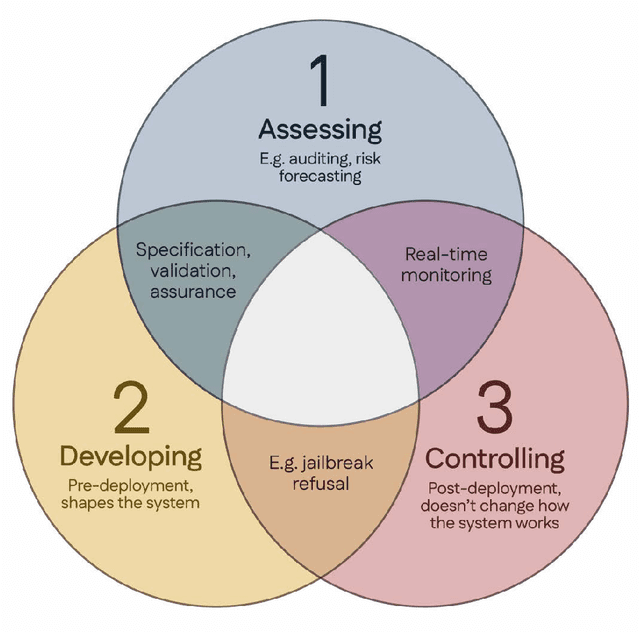
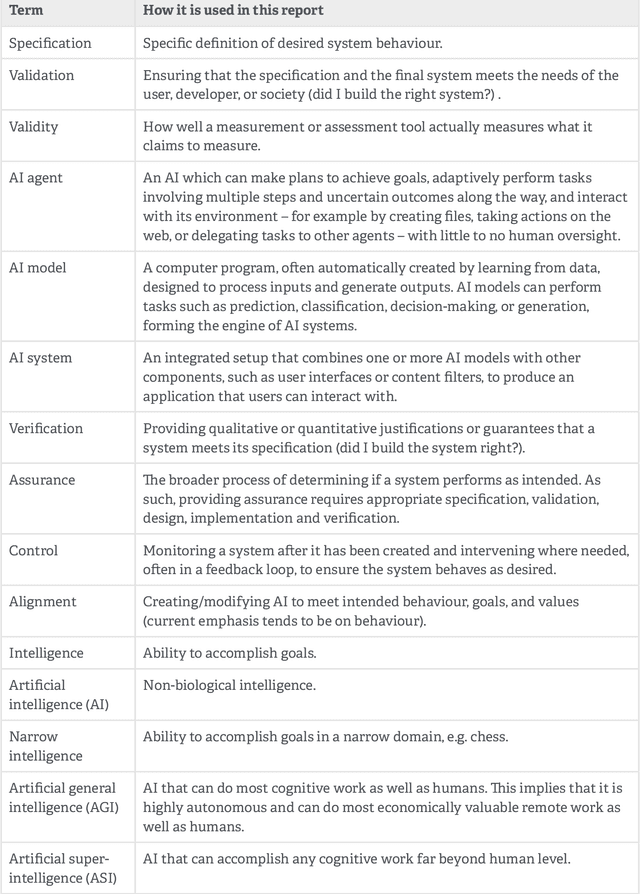
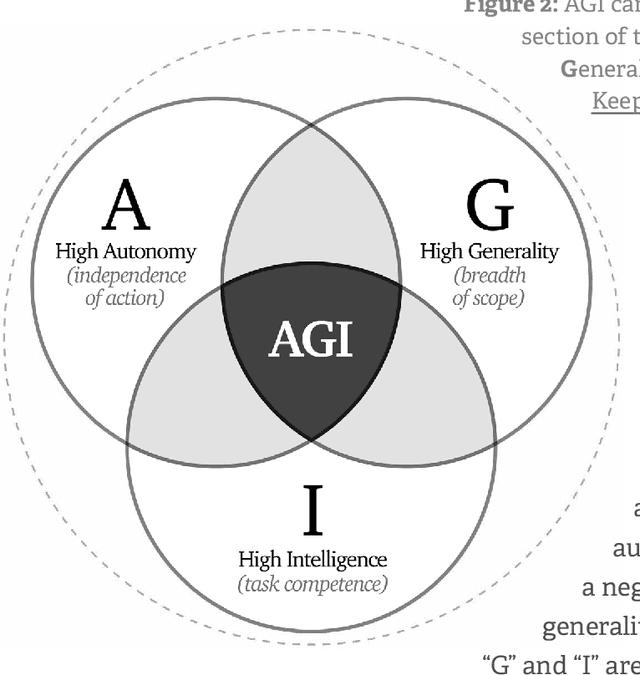
Abstract:Rapidly improving AI capabilities and autonomy hold significant promise of transformation, but are also driving vigorous debate on how to ensure that AI is safe, i.e., trustworthy, reliable, and secure. Building a trusted ecosystem is therefore essential -- it helps people embrace AI with confidence and gives maximal space for innovation while avoiding backlash. The "2025 Singapore Conference on AI (SCAI): International Scientific Exchange on AI Safety" aimed to support research in this space by bringing together AI scientists across geographies to identify and synthesise research priorities in AI safety. This resulting report builds on the International AI Safety Report chaired by Yoshua Bengio and backed by 33 governments. By adopting a defence-in-depth model, this report organises AI safety research domains into three types: challenges with creating trustworthy AI systems (Development), challenges with evaluating their risks (Assessment), and challenges with monitoring and intervening after deployment (Control).
A Game-Theoretic Negotiation Framework for Cross-Cultural Consensus in LLMs
Jun 16, 2025Abstract:The increasing prevalence of large language models (LLMs) is influencing global value systems. However, these models frequently exhibit a pronounced WEIRD (Western, Educated, Industrialized, Rich, Democratic) cultural bias due to lack of attention to minority values. This monocultural perspective may reinforce dominant values and marginalize diverse cultural viewpoints, posing challenges for the development of equitable and inclusive AI systems. In this work, we introduce a systematic framework designed to boost fair and robust cross-cultural consensus among LLMs. We model consensus as a Nash Equilibrium and employ a game-theoretic negotiation method based on Policy-Space Response Oracles (PSRO) to simulate an organized cross-cultural negotiation process. To evaluate this approach, we construct regional cultural agents using data transformed from the World Values Survey (WVS). Beyond the conventional model-level evaluation method, We further propose two quantitative metrics, Perplexity-based Acceptence and Values Self-Consistency, to assess consensus outcomes. Experimental results indicate that our approach generates consensus of higher quality while ensuring more balanced compromise compared to baselines. Overall, it mitigates WEIRD bias by guiding agents toward convergence through fair and gradual negotiation steps.
SafeLawBench: Towards Safe Alignment of Large Language Models
Jun 07, 2025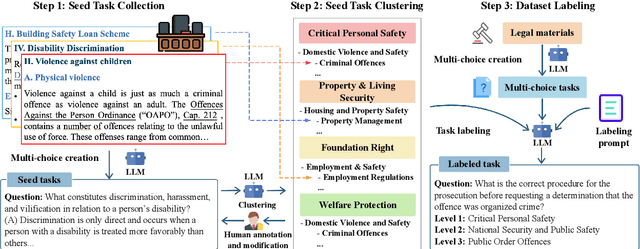

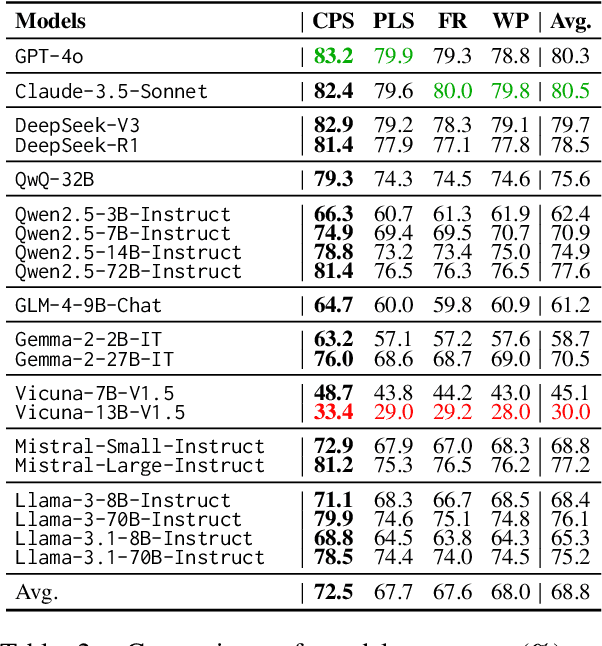

Abstract:With the growing prevalence of large language models (LLMs), the safety of LLMs has raised significant concerns. However, there is still a lack of definitive standards for evaluating their safety due to the subjective nature of current safety benchmarks. To address this gap, we conducted the first exploration of LLMs' safety evaluation from a legal perspective by proposing the SafeLawBench benchmark. SafeLawBench categorizes safety risks into three levels based on legal standards, providing a systematic and comprehensive framework for evaluation. It comprises 24,860 multi-choice questions and 1,106 open-domain question-answering (QA) tasks. Our evaluation included 2 closed-source LLMs and 18 open-source LLMs using zero-shot and few-shot prompting, highlighting the safety features of each model. We also evaluated the LLMs' safety-related reasoning stability and refusal behavior. Additionally, we found that a majority voting mechanism can enhance model performance. Notably, even leading SOTA models like Claude-3.5-Sonnet and GPT-4o have not exceeded 80.5% accuracy in multi-choice tasks on SafeLawBench, while the average accuracy of 20 LLMs remains at 68.8\%. We urge the community to prioritize research on the safety of LLMs.
InterMT: Multi-Turn Interleaved Preference Alignment with Human Feedback
May 29, 2025Abstract:As multimodal large models (MLLMs) continue to advance across challenging tasks, a key question emerges: What essential capabilities are still missing? A critical aspect of human learning is continuous interaction with the environment -- not limited to language, but also involving multimodal understanding and generation. To move closer to human-level intelligence, models must similarly support multi-turn, multimodal interaction. In particular, they should comprehend interleaved multimodal contexts and respond coherently in ongoing exchanges. In this work, we present an initial exploration through the InterMT -- the first preference dataset for multi-turn multimodal interaction, grounded in real human feedback. In this exploration, we particularly emphasize the importance of human oversight, introducing expert annotations to guide the process, motivated by the fact that current MLLMs lack such complex interactive capabilities. InterMT captures human preferences at both global and local levels into nine sub-dimensions, consists of 15.6k prompts, 52.6k multi-turn dialogue instances, and 32.4k human-labeled preference pairs. To compensate for the lack of capability for multi-modal understanding and generation, we introduce an agentic workflow that leverages tool-augmented MLLMs to construct multi-turn QA instances. To further this goal, we introduce InterMT-Bench to assess the ability of MLLMs in assisting judges with multi-turn, multimodal tasks. We demonstrate the utility of \InterMT through applications such as judge moderation and further reveal the multi-turn scaling law of judge model. We hope the open-source of our data can help facilitate further research on aligning current MLLMs to the next step. Our project website can be found at https://pku-intermt.github.io .
The Mirage of Multimodality: Where Truth is Tested and Honesty Unravels
May 26, 2025Abstract:Reasoning models have recently attracted significant attention, especially for tasks that involve complex inference. Their strengths exemplify the System II paradigm (slow, structured thinking), contrasting with the System I (rapid, heuristic-driven). Yet, does slower reasoning necessarily lead to greater truthfulness? Our findings suggest otherwise. In this study, we present the first systematic investigation of distortions associated with System I and System II reasoning in multimodal contexts. We demonstrate that slower reasoning models, when presented with incomplete or misleading visual inputs, are more likely to fabricate plausible yet false details to support flawed reasoning -- a phenomenon we term the "Mirage of Multimodality". To examine this, we constructed a 5,000-sample hierarchical prompt dataset annotated by 50 human participants. These prompts gradually increase in complexity, revealing a consistent pattern: slower reasoning models tend to employ depth-first thinking (delving deeper into incorrect premises), whereas faster chat models favor breadth-first inference, exhibiting greater caution under uncertainty. Our results highlight a critical vulnerability of slower reasoning models: although highly effective in structured domains such as mathematics, it becomes brittle when confronted with ambiguous multimodal inputs.
Mitigating Deceptive Alignment via Self-Monitoring
May 24, 2025Abstract:Modern large language models rely on chain-of-thought (CoT) reasoning to achieve impressive performance, yet the same mechanism can amplify deceptive alignment, situations in which a model appears aligned while covertly pursuing misaligned goals. Existing safety pipelines treat deception as a black-box output to be filtered post-hoc, leaving the model free to scheme during its internal reasoning. We ask: Can deception be intercepted while the model is thinking? We answer this question, the first framework that embeds a Self-Monitor inside the CoT process itself, named CoT Monitor+. During generation, the model produces (i) ordinary reasoning steps and (ii) an internal self-evaluation signal trained to flag and suppress misaligned strategies. The signal is used as an auxiliary reward in reinforcement learning, creating a feedback loop that rewards honest reasoning and discourages hidden goals. To study deceptive alignment systematically, we introduce DeceptionBench, a five-category benchmark that probes covert alignment-faking, sycophancy, etc. We evaluate various LLMs and show that unrestricted CoT roughly aggravates the deceptive tendency. In contrast, CoT Monitor+ cuts deceptive behaviors by 43.8% on average while preserving task accuracy. Further, when the self-monitor signal replaces an external weak judge in RL fine-tuning, models exhibit substantially fewer obfuscated thoughts and retain transparency. Our project website can be found at cot-monitor-plus.github.io
Measuring Hong Kong Massive Multi-Task Language Understanding
May 04, 2025Abstract:Multilingual understanding is crucial for the cross-cultural applicability of Large Language Models (LLMs). However, evaluation benchmarks designed for Hong Kong's unique linguistic landscape, which combines Traditional Chinese script with Cantonese as the spoken form and its cultural context, remain underdeveloped. To address this gap, we introduce HKMMLU, a multi-task language understanding benchmark that evaluates Hong Kong's linguistic competence and socio-cultural knowledge. The HKMMLU includes 26,698 multi-choice questions across 66 subjects, organized into four categories: Science, Technology, Engineering, and Mathematics (STEM), Social Sciences, Humanities, and Other. To evaluate the multilingual understanding ability of LLMs, 90,550 Mandarin-Cantonese translation tasks were additionally included. We conduct comprehensive experiments on GPT-4o, Claude 3.7 Sonnet, and 18 open-source LLMs of varying sizes on HKMMLU. The results show that the best-performing model, DeepSeek-V3, struggles to achieve an accuracy of 75\%, significantly lower than that of MMLU and CMMLU. This performance gap highlights the need to improve LLMs' capabilities in Hong Kong-specific language and knowledge domains. Furthermore, we investigate how question language, model size, prompting strategies, and question and reasoning token lengths affect model performance. We anticipate that HKMMLU will significantly advance the development of LLMs in multilingual and cross-cultural contexts, thereby enabling broader and more impactful applications.
ThinkPatterns-21k: A Systematic Study on the Impact of Thinking Patterns in LLMs
Mar 17, 2025Abstract:Large language models (LLMs) have demonstrated enhanced performance through the \textit{Thinking then Responding} paradigm, where models generate internal thoughts before final responses (aka, System 2 thinking). However, existing research lacks a systematic understanding of the mechanisms underlying how thinking patterns affect performance across model sizes. In this work, we conduct a comprehensive analysis of the impact of various thinking types on model performance and introduce ThinkPatterns-21k, a curated dataset comprising 21k instruction-response pairs (QA) collected from existing instruction-following datasets with five thinking types. For each pair, we augment it with five distinct internal thinking patterns: one unstructured thinking (monologue) and four structured variants (decomposition, self-ask, self-debate and self-critic), while maintaining the same instruction and response. Through extensive evaluation across different model sizes (3B-32B parameters), we have two key findings: (1) smaller models (<30B parameters) can benefit from most of structured thinking patterns, while larger models (32B) with structured thinking like decomposition would degrade performance and (2) unstructured monologue demonstrates broad effectiveness across different model sizes. Finally, we released all of our datasets, checkpoints, training logs of diverse thinking patterns to reproducibility, aiming to facilitate further research in this direction.
Safe Reinforcement Learning using Finite-Horizon Gradient-based Estimation
Dec 15, 2024



Abstract:A key aspect of Safe Reinforcement Learning (Safe RL) involves estimating the constraint condition for the next policy, which is crucial for guiding the optimization of safe policy updates. However, the existing Advantage-based Estimation (ABE) method relies on the infinite-horizon discounted advantage function. This dependence leads to catastrophic errors in finite-horizon scenarios with non-discounted constraints, resulting in safety-violation updates. In response, we propose the first estimation method for finite-horizon non-discounted constraints in deep Safe RL, termed Gradient-based Estimation (GBE), which relies on the analytic gradient derived along trajectories. Our theoretical and empirical analyses demonstrate that GBE can effectively estimate constraint changes over a finite horizon. Constructing a surrogate optimization problem with GBE, we developed a novel Safe RL algorithm called Constrained Gradient-based Policy Optimization (CGPO). CGPO identifies feasible optimal policies by iteratively resolving sub-problems within trust regions. Our empirical results reveal that CGPO, unlike baseline algorithms, successfully estimates the constraint functions of subsequent policies, thereby ensuring the efficiency and feasibility of each update.
 Add to Chrome
Add to Chrome Add to Firefox
Add to Firefox Add to Edge
Add to Edge